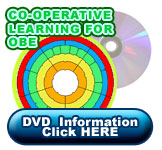Multiple Intelligences
together with Co-operative Learning is a sure way to enhance learning.
Find out
- What the Multiple Intelligences are
- Why teaching with Multiple Intelligences helps the brain to learn more and better
- Where these intelligences are in our brains
1. What are the Multiple Intelligences?
How smart are you?
 This question assumes that we can readily measure your intelligence. All we need is a pen and pencil, sit you down at a desk, and have you perform some isolated tasks that you have never done before, may never do again, and may seem pointless to you, in an attempt to assess how good you are at using language and performing logical and mathematical operations. This traditional understanding of intelligence dates back to 1904. This notion suggests that your intelligence can be objectively measured and reduced to a single number or “IQ” score. It holds that your IQ remains fixed throughout your life. Your age may change, but your IQ score remains the same.
This question assumes that we can readily measure your intelligence. All we need is a pen and pencil, sit you down at a desk, and have you perform some isolated tasks that you have never done before, may never do again, and may seem pointless to you, in an attempt to assess how good you are at using language and performing logical and mathematical operations. This traditional understanding of intelligence dates back to 1904. This notion suggests that your intelligence can be objectively measured and reduced to a single number or “IQ” score. It holds that your IQ remains fixed throughout your life. Your age may change, but your IQ score remains the same.
This understanding about cognition has influenced what we value in our society and what we teach in our schools. During school hours we focus on developing learners’ linguistic ability, i.e. vocabulary, word usage, expressing oneself through writing, speaking, reading, and mathematical, scientific and logical ways of thinking and performing operations. We tend to believe a person is very intelligent if they are highly articulate and logical. We tend to hold in less esteem those who are artists, actors, architects, musicians, environmentalists, dancers, athletes, designers, entrepreneurs, others who also make significant contributions to our world and society. When learners excel in these ‘lesser’ attributes, yet struggle with the more traditional subjects of language and mathematics, they may at times end up being labeled as learning disabled, discipline problems, underachievers, even ADD (Attention Deficit Disorder) candidates because of their unique ways of understanding and expressing themselves.
In 1983, an education professor from Harvard University, named Howard Gardner, challenged the traditional notion that Intelligence can be measured as a single capacity. Based on his and subsequent brain research, we have in fact discovered that the mind processes information in many different areas of the brain. Gardner proposed that intelligence has many dimensions and are present at multiple levels of our brain, mind and body; we have varying strengths in these intelligences, they are not fixed from birth, and can be learned, taught and enhanced throughout our lives.
Howard Garden’s Theory of Multiple Intelligences suggests that there are some eight distinct and equally important ways people can express themselves and experience the world, which he calls Intelligences:
Linguistic intelligence (word smart)
Logical/mathematical intelligence (number / reasoning smart)
Visual/spatial intelligence (picture smart)
Bodily/kinesthetic intelligence (body smart)
Musical/rhythmic intelligence (music smart)
Interpersonal intelligence (people smart)
Intrapersonal intelligence (self smart)
Naturalist intelligence (nature smart)
◊—–◊—–◊—–◊—–◊—–◊—–◊—–◊—–◊—–◊—–◊—–◊—–◊—–◊—–◊—–◊—–◊—– pg. top
With this in mind, we may want to change our question to: How are you smart?
This new view of intelligence has the potential to influence what we teach and how we teach it in the classroom, even how we perceive our learners. What could be construed as a disruptive child, who is constantly interrupting the lesson by talking, could also be seen as a child with a strong interpersonal intelligence. Teachers could channel this intelligence by using Co-operative Learning groupwork tasks and enable the learner to interact around the learning goals, to better learn and comprehend the content through his Interpersonal Intelligence. Similarly, the child who is constantly ‘doodling’ and drawing on her paper, could benefit by drawing the relationships between key ideas or by visualising what the concept looks like in her mind’s eye and apply her Visual Intelligence to learning. By matching our instruction with how learners are smart we can build multiple bridges on to our curriculum and give our diverse population of learners equal access to the learning material. In this way we can make learning more meaningful and engaging for all learners so that everyone can succeed.
The Theory of Multiple Intelligences offers educators a way to teach to learners’ strengths and thus reach many more learners than we would by restricting ourselves to logical and linguistic approaches to teaching and assessing learning. Multiple Intelligences can open many pathways to learning and developing the whole child. It allows us to celebrate our learners’ and our own talents and gifts. It is one sure way to bring fun back into learning and get smarter at the same time!
◊—–◊—–◊—–◊—–◊—–◊—–◊—–◊—–◊—–◊—–◊—–◊—–◊—–◊—–◊—–◊—–◊—– pg. top
2. Why teaching with MI helps the brain to learn more and better.
Actively engaging with the curriculum outcomes through different intelligences, enables learners’ brains to better understand and process the new information to be learned. It stimulates neural activity and better enables the brain to make connections between old knowledge and new information, and thus form new and more complex neural pathways. In this way, the new information to be learned is more able to become knowledge in permanent memory. Appealing to learners’ Multiple Intelligences enables them to better remember previous learning experience and build upon what they already know and create new knowledge. Together with Co-operative Learning, teaching with Multiple Intelligences enables learners to learn more, learn faster and learn better while having fun!
◊—–◊—–◊—–◊—–◊—–◊—–◊—–◊—–◊—–◊—–◊—–◊—–◊—–◊—–◊—–◊—–◊—– pg. top
3. Where are these intelligences in our brains?
In our latest Professional Development DVD, Thinking Powers for Reading Comprehension, we show WHY the brain benefits from Multiple Intelligences on a biological level! In an animation of how the brain processes information and learns we see that different types of information and ways of receiving information are processed in different areas of the brain. Therefore, designing groupwork tasks with Multiple Intelligences and Co-operative Learning is a sure win!
Click Here to view animation of how the brain processes information
◊—–◊—–◊—–◊—–◊—–◊—–◊—–◊—–◊—–◊—–◊—–◊—–◊—–◊—–◊—–◊—–◊—– pg. top


